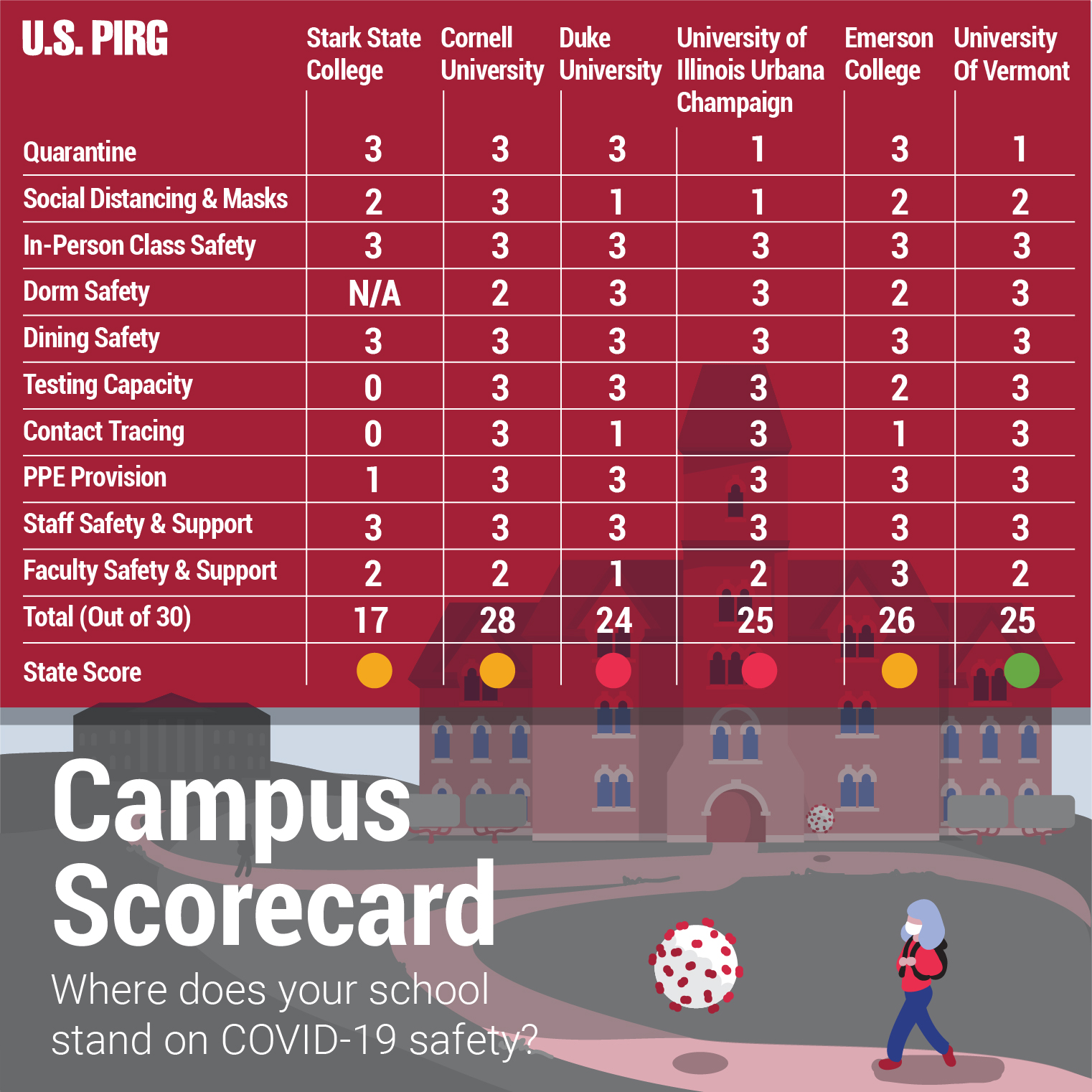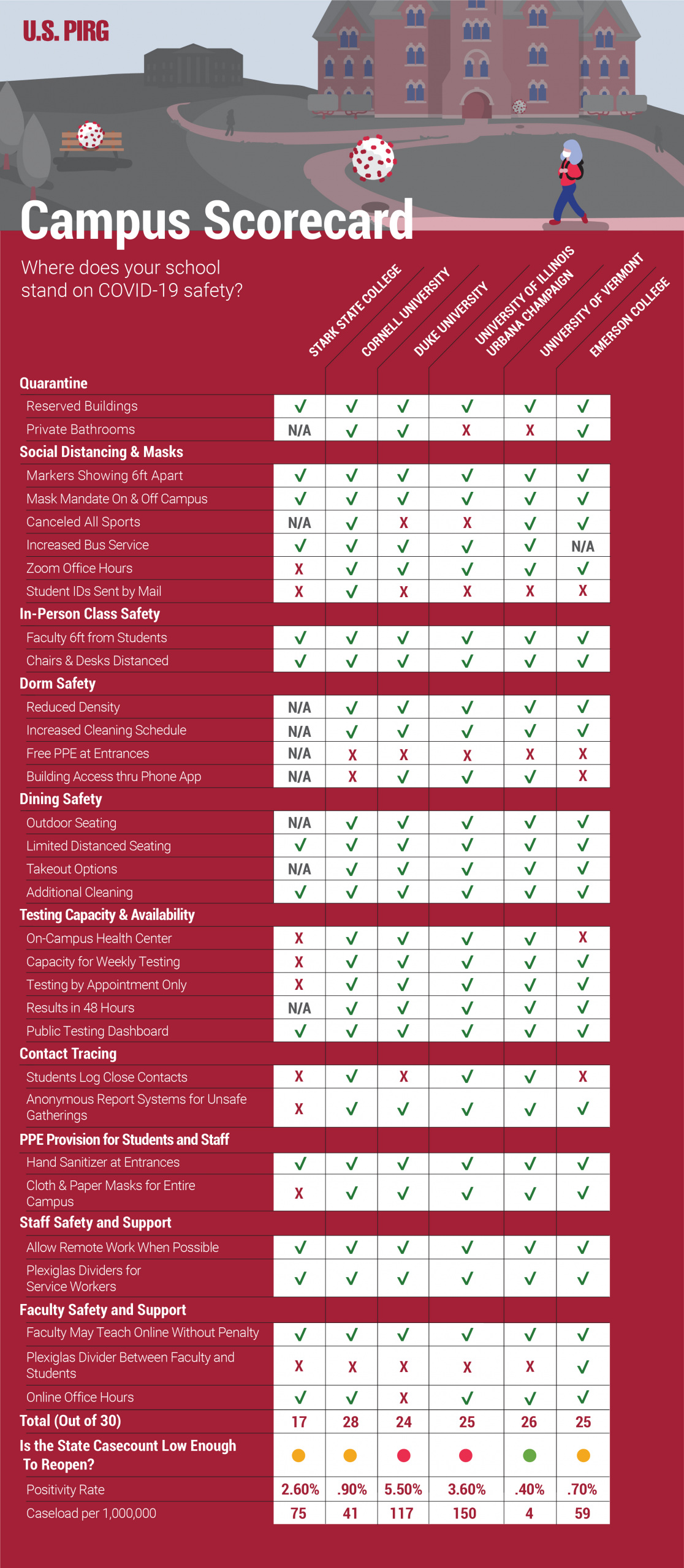
Zack Szlezinger
Former Field Organizer, Student PIRGs
Colleges all over the country have decided to open their doors to students, but reopening remains unsafe in nearly all states.
Former Field Organizer, Student PIRGs
This term, many colleges have made the decision to fully or partially reopen their campuses to students, and they have done so to varying degrees of success. As of September 9th, over 80 percent of colleges were offering online or hybrid programs. And that’s probably for the best. According to new research from the College Crisis Initiative at Davidson College, a major driver in the late-summer surge in COVID-19 cases is due to face-to-face instruction on college campuses.
The best practice for protecting college students and college communities from COVID-19 is not to reopen at all. Unless there is a low number of cases in their state, a low transmission rate, and the college takes aggressive steps to control community spread, institutions should be working and learning remotely as much as possible.
According to data from the COVID Exit Strategy on September 25th, 2020, 22 states are at a level of uncontrolled spread, and all but 16 states are trending poorly. Colleges should only consider reopening their campuses if the state they are in has a new daily caseload of less than 10 per million and a test positivity rate of 3 percent or lower. Currently, only Vermont, New Hampshire, and Maine are actually safe to reopen. Those in states that meet these benchmarks should make sure that they take some of these steps to protect their students, faculty, and staff before reopening their campuses:

University of Vermont
The University of Vermont is located in the small city of Burlington. Vermont has approximately a .4 percent positivity rate and approximately 5 cases per million, so they are in a range where it is relatively safe to open. While it is the flagship public school, due to the small population of the state, the majority of students are from out of state and pose a significant health risk to the rest of the state. As the university developed its reopening plan, the Burlington government was concerned that students would contribute to spreading COVID-19 in the community, as many upperclassmen live off campus. After some initial sparring over the summer, the city of Burlington and the University of Vermont worked in close collaboration to develop a reopening plan. The plan views students as core community members and requires that the city, the university, on-campus students, and all city residents take actions to slow the spread of COVID-19 in Burlington.
The city of Burlington has limited all outdoor gatherings to include no more than 25 people, and indoor gatherings to include no more than ten. Police officers have been stationed in areas around campus in order to enforce this rule and ticket violators. Restaurants and bars have also been prohibited from selling alcohol past 10PM. The coordination between the city and the university seems to be working so far, as very few cases have been reported at UVM.
According to UVM’s Restart Plan in July, on- and off-campus students must quarantine for two weeks if they are from a state or county where Vermont requires quarantine. If parents move their students in, they must quarantine for the required two weeks as well. Students must also document all of their contacts and get tested weekly; missing tests can result in suspension. All triple and quad rooms have been eliminated in order to reduce density of dorms, and guests from out of town are not allowed into dorm buildings. When in-person classes do occur, the school has laid out classroom sanitizing procedures that faculty are expected to enforce, and worked to develop new guidelines for custodial and operations staff to enhance safety.
Cornell University
Ithaca, New York is a small, rural city in upstate New York, which is home to both Cornell University and Ithaca College. Cornell is much bigger than Ithaca with over 21,000 students, while Ithaca has just under 7,000. Despite being in the same city, the two colleges have taken different approaches to keep their students safe. New York was in the acceptable COVID-19 case range to open when Cornell opened, but now it has a caseload of approximately 40 per million, which is not within the advisable range to open.
Cornell’s reopening plan is based around the idea that students will be safer in Cornell housing than if the campus was closed , which might prompt large numbers of students to live in the surrounding area with little oversight or in more contagious hometowns. Students who live on Cornell’s campus or are taking classes in person at Cornell are required to comply with all CDC guidelines and must take daily health surveys as well as weekly COVID-19 tests. The university has also launched the Live Smarter campaign, which enlists students as “ambassadors” encouraging their peers to follow school guidelines to keep campus and Ithaca as a whole safe.
Students are required to socially distance and wear masks at all times on campus, all classes have assigned seating with chairs and desks spread out. The university has also designated several dorm buildings for quarantine and requires all students to self-quarantine upon arrival to Ithaca — two weeks for those from states with New York State travel advisories or international locations, and 24 hours and until they receive a negative test result for other students. Some of the precautionary measures that Cornell outlined were inconsistently implemented, leading to a strike led by resident advisors in August. The strike began with 50 RAs who were upset about the university’s weak enforcement of COVID-19 precautions; after the university agreed to step up public safety measures, the resident advisor collective refocused on their demands for hazard pay and basic needs support. Since then, Cornell has maintained a low case count according to its testing dashboard, but New York as a whole is beginning to trend poorly.
Ithaca College initially planned to reopen with a similar plan to Cornell, but on August 18th it announced that it would keep its classes and student life online for the majority of students. Ithaca does not have the same amount of dormitory housing that Cornell does to create adequate quarantine buildings, and was concerned the quality of student life would be poor. The only students who have been allowed back are those with hands-on course requirements, such as those studying health sciences, and those with extenuating personal circumstances.
University of Illinois – Urbana Champaign
The university’s Carle Illinois School of Medicine developed its own rapid COVID-19 saliva test, which can give results in just hours. UI staff have set up 17 testing sites all over campus, including an on-campus lab, the campus gym, and the student union. Students are required to get tested twice every week, stay in dorms unless essential, and adhere to all other CDC guidelines or face immediate suspension.
Despite the college’s testing capacity and strong systemwide reopening plan laid out in June, it experienced a spike in positive COVID-19 tests, which were traced back to off-campus gatherings and parties, largely at fraternity houses. It immediately took disciplinary action against students who were not adhering to CDC guidelines in hopes of deterring such behavior. Unlike other colleges and universities, which closed in response to outbreaks early on in their terms, the University of Illinois is hoping to recover from the outbreak with students still on campus with its large testing capacity. The outbreak that the university has seen should be a sign to other colleges in Illinois that the state has not reached a level where it is safe to be open, and continues to trend poorly
Emerson College
Emerson College is a small college in Boston, with approximately 3,800 students. Emerson’s reopening plan has welcomed all of its students back to Boston this semester, while minimizing health and safety risks on its small urban campus. Emerson has opened all of its residence halls, dining halls, and classroom spaces, while taking steps to de-densify these spaces. Class times are staggered to reduce traffic, and spaces that are not traditionally classrooms, such as theatres, will be used as class spaces.
The majority of Emerson’s students are from outside of Massachusetts, and 18 percent are international students. Regardless of where they are coming from, Emerson required all students to self-quarantine and monitor their symptoms on an app before arrival on campus. After their arrival on campus, students are required to get tested weekly; while Emerson does not have an on-campus clinic, their close proximity to the Tufts Medical Center allows students relatively easy access to a test site.. Since Emerson began to welcome students back on August 6, it has had 11 COVID-19 cases, and since the beginning of September, it has only had three. The actions that Emerson has taken have been successful, but the COVID-19 situation in Massachusetts has worsened. Its downtown Boston location means that many students commute from off-campus apartments, and are at greater risk of external COVID exposure. This should signal to Emerson administration that staying open could become unsafe, and the best practice for the college would be to shift instruction online if the state trends worsen
Stark State College
Stark State College is a community college in Canton, Ohio. The multi-campus college serves approximately 15,000 students and offers one-year certificates and associate’s degrees. Stark State closed campus and went online in March, but reopened over three months ago for the start of the summer session, and has only experienced one confirmed case of COVID-19.
According to the COVID Exit Strategy, Ohio’s rate of new cases is 76 per million residents, which is not low enough for colleges there to open safely. Stark County is doing significantly better compared to Ohio’s average but is still far from a desirable level of cases. The situation could get out of control quickly as Stark State merely shares data on reported cases, and does not do any testing of the campus community itself. Although Stark State has been successful thus far, colleges in similar positions at the point of reopening should not reopen unless there is a stronger testing and contract tracing regime in place.
Commuter college students tend to be more active off campus and in their wider communities than those who attend residential colleges, which can be a challenge for developing a strong reopening plan during the pandemic. Stark State has been able to remain almost completely COVID-19-free by taking, “a measured approach, and then some” beyond the state government’s recommendations.
Because Stark State is a commuter school, they put a large emphasis on checking in with students as they come and go from campus each day. At all entrances, people must take their temperature as they enter, and hand sanitizer and masks are available. Most classes have been moved online to decrease campus density, and those that are in person have 10-12 students and staggered start and end times. Although no students live on campus, there are quarantine spaces available in case anyone is exposed to COVID-19 and cannot be transported somewhere else.
Duke University
North Carolina has been trending negatively with COVID-19, and universities such as North Carolina State University and the University of North Carolina at Chapel Hill closed shortly after opening due to outbreaks on their campuses. Duke University, a private school located in Durham, NC, has been more successful at protecting its students, faculty, and staff from COVID-19 thus far. Despite reducing the number of on-campus students from their original plan when Durham reported increased cases, Duke students are still at risk because of the state of the pandemic in the wider metro area, and the state as a whole.
According to the updated reopening plan, only freshmen and sophomores are allowed to live in on-campus dorms, while upperclassmen must live off-campus. This action reduced campus density by 30 percent, and allowed the university to give almost all of its on-campus students single rooms so that quarantines can take place in a student’s own room. All on-campus students who come to Duke from outside of Durham were told to self-quarantine for two weeks before returning to campus and were only welcomed back if they have a negative test result. The students living off-campus may take classes in person and use limited academic spaces if they participate in testing, but they are prohibited from using other spaces, such as campus recreation centers and dining halls.
All students, faculty, and staff must take a pledge before they return to campus to adhere to CDC guidelines, participate in contact tracing, and take regular COVID-19 tests. In order to make the most of their limited resources, Duke is using a pool surveillance testing model. This means that they take samples from several people, combine part of each of them, and test them together. If a pooled sample tests positive, lab technicians review each of the individual samples from the pool to see which community member is COVID-19 positive.
California State University
The California State University is the largest four-year public university system in the US, and was the first to announce that it would continue with remote instruction for the fall semester on May 12 and on September 10, the first to announce online instruction for the spring. With the exception of some lab classes that require hands-on instruction, Cal State will be closed for the entire fall semester.
Cal State made this decision in part because of its size. There are over 500,000 students that take classes across the 23 colleges in the system, so the administration decided that keeping that many people out of close proximity was the best decision for the university system. By making the decision to remain online months before the school year, Cal State has had time to train faculty to teach online courses and develop online learning, entertainment, and social action resources for students.
Cal State campuses have maintained many of their student services, moving online when possible, but maintaining some physical services in order to provide for students’ basic needs. For example, Cal State Chico has maintained its food pantry and student health services by appointment only, while shifting other services, like IT and mental health services, to a remote context.
Even with ample precautions in place, it is difficult for colleges to control outbreaks of COVID-19, especially as students may not adhere to all social distancing guidelines. This is why it is important for colleges to pay attention to the situation around their campuses and in their states and only open when it will not compromise the safety of their students, faculty, and staff, and the community around them.

Former Field Organizer, Student PIRGs